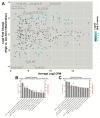Extracellular Vesicles in Synovial Fluid from Rheumatoid Arthritis Patients Contain miRNAs with Capacity to Modulate Inflammation
- PMID: 34066338
- PMCID: PMC8125513
- DOI: 10.3390/ijms22094910
Extracellular Vesicles in Synovial Fluid from Rheumatoid Arthritis Patients Contain miRNAs with Capacity to Modulate Inflammation
Abstract
In rheumatoid arthritis (RA), extracellular vesicles (EVs) are associated with both the propagation and attenuation of joint inflammation and destruction. However, the specific EV content responsible for these processes is largely unknown. Investigations into identifying EV content are confounded by the challenges in obtaining high-quality EV preparations from synovial fluid. Implementing a size exclusion chromatography-based method of EV isolation, coupled with small RNA sequencing, we accurately characterised EV miRNAs in synovial fluid obtained from RA patients and investigated the differences between joints with high- and low-grade inflammation. Synovial fluid was obtained from the joints of 12 RA patients and, based on leukocyte counts, classified as either high (n = 7)- or low (n = 5)-grade inflammation. Using size exclusion chromatography, EVs were purified and small RNA was extracted and sequenced on a NextSeq 500. Sequencing reads were aligned to miRBase v21, and differences in miRNA profiles between RA patients with high- and low-grade joint inflammation were analysed. In total, 1972 distinct miRNAs were identified from RA synovial fluid EVs. miRNAs with less than five reads in fewer than five patients were filtered out, leaving 318 miRNAs for analysis. Analysis of the most abundant miRNAs suggested that they negatively regulate multiple genes relevant to inflammation, including signal transducer and activator of transcription 3 (STAT3), which lies downstream of IL-6 and has a pro-inflammatory role in RA. Synovial fluid from joints with high-grade inflammation contained 3.5-fold more EV miRNA per mL of synovial fluid (p = 0.0017). Seventy-eight EV miRNAs were differentially expressed between RA joints with high- and low-grade inflammation, and pathway analysis revealed that their target genes were commonly involved a variety of processes, including cellular apoptosis, proliferation and migration. Of the 49 miRNAs that were elevated in joints with high-grade inflammation, pathway analysis revealed that genes involved in cytokine-mediated signalling pathways were significantly enriched targets. In contrast, genes associated with reactive oxygen species signalling were significantly enriched as targets of the 29 miRNAs elevated in joints with low-grade inflammation. Our study identified an abundance of EV miRNAs from the synovial fluid of RA patients with the potential to modulate inflammation. In doing so, we defined potential mechanisms by which synovial fluid EVs may contribute to RA pathophysiology.
Keywords: extracellular vesicles; miRNA; rheumatoid arthritis; synovial fluid.
Conflict of interest statement
The authors report no conflict of interest.
Figures



Similar articles
-
Proteomic analysis of extracellular vesicles reveals an immunogenic cargo in rheumatoid arthritis synovial fluid.Clin Transl Immunology. 2020 Nov 7;9(11):e1185. doi: 10.1002/cti2.1185. eCollection 2020. Clin Transl Immunology. 2020. PMID: 33204424 Free PMC article.
-
Fibroblast expression of neurotransmitter receptor HTR2A associates with inflammation in rheumatoid arthritis joint.Clin Exp Med. 2024 Apr 25;24(1):84. doi: 10.1007/s10238-024-01352-w. Clin Exp Med. 2024. PMID: 38662111 Free PMC article.
-
miR-34a in extracellular vesicles from bone marrow mesenchymal stem cells reduces rheumatoid arthritis inflammation via the cyclin I/ATM/ATR/p53 axis.J Cell Mol Med. 2021 Feb;25(4):1896-1910. doi: 10.1111/jcmm.15857. Epub 2021 Jan 19. J Cell Mol Med. 2021. PMID: 33465281 Free PMC article.
-
Therapeutic prospects of microRNAs derived from mesenchymal stem cell extracellular vesicles in rheumatoid arthritis: a comprehensive overview.Mol Cell Biochem. 2025 Mar;480(3):1275-1286. doi: 10.1007/s11010-024-05082-1. Epub 2024 Aug 6. Mol Cell Biochem. 2025. PMID: 39105963 Review.
-
Wnt signaling pathway in rheumatoid arthritis, with special emphasis on the different roles in synovial inflammation and bone remodeling.Cell Signal. 2013 Oct;25(10):2069-78. doi: 10.1016/j.cellsig.2013.04.002. Epub 2013 Apr 17. Cell Signal. 2013. PMID: 23602936 Review.
Cited by
-
Exploration of Exosomal miRNAs from Serum and Synovial Fluid in Arthritis Patients.Diagnostics (Basel). 2022 Jan 19;12(2):239. doi: 10.3390/diagnostics12020239. Diagnostics (Basel). 2022. PMID: 35204330 Free PMC article.
-
MicroRNAs in Juvenile Idiopathic Arthritis: State of the Art and Future Perspectives.Biology (Basel). 2023 Jul 12;12(7):991. doi: 10.3390/biology12070991. Biology (Basel). 2023. PMID: 37508421 Free PMC article. Review.
-
Technological Approaches in the Analysis of Extracellular Vesicle Nucleotide Sequences.Front Bioeng Biotechnol. 2021 Dec 23;9:787551. doi: 10.3389/fbioe.2021.787551. eCollection 2021. Front Bioeng Biotechnol. 2021. PMID: 35004647 Free PMC article. Review.
-
Synovial fluid extracellular vesicles as arthritis biomarkers: the added value of lipid-profiling and integrated omics.Extracell Vesicles Circ Nucl Acids. 2024 Jun 13;5(2):276-296. doi: 10.20517/evcna.2024.14. eCollection 2024. Extracell Vesicles Circ Nucl Acids. 2024. PMID: 39698533 Free PMC article. Review.
-
[Plumbagin protect against sepsis-induced myocardial injury in mice by inhibiting the JAK2/STAT3 signaling pathway to reduce cardiomyocyte pyroptosis].Nan Fang Yi Ke Da Xue Xue Bao. 2024 Nov 20;44(11):2209-2219. doi: 10.12122/j.issn.1673-4254.2024.11.18. Nan Fang Yi Ke Da Xue Xue Bao. 2024. PMID: 39623277 Free PMC article. Chinese.
References
MeSH terms
Substances
Grants and funding
LinkOut - more resources
Full Text Sources
Other Literature Sources
Medical
Miscellaneous

